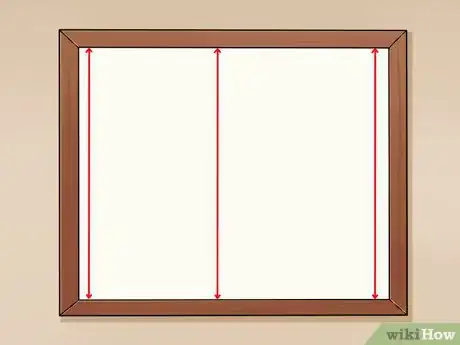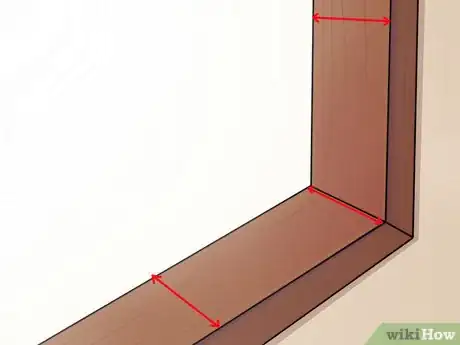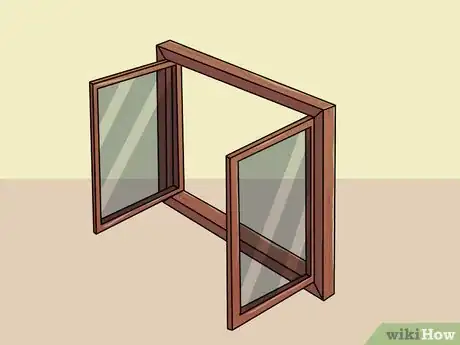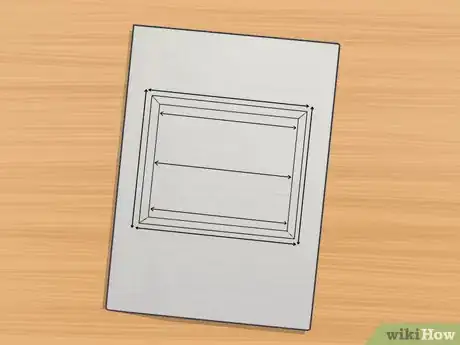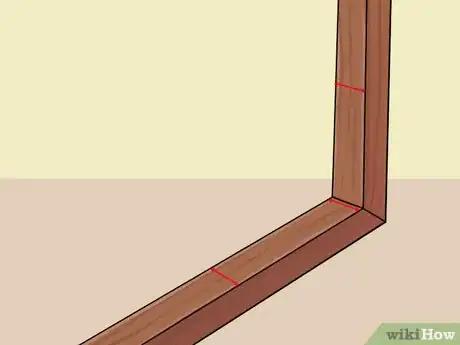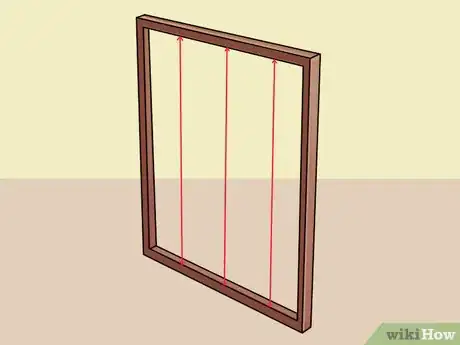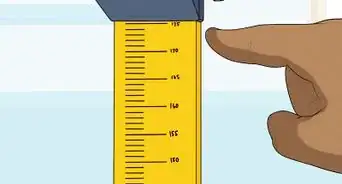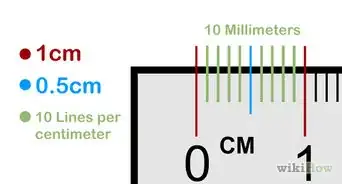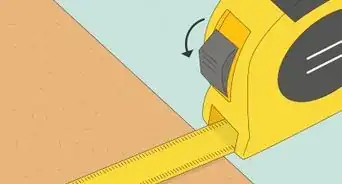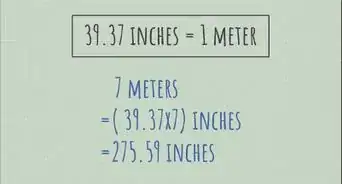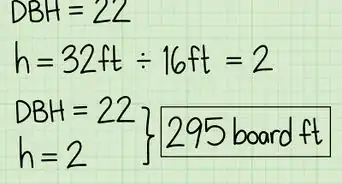This article was co-authored by Ben Barlow. Ben Barlow is a Window Cleaning Specialist and the Owner of Barlow Window Bros based in Provo, Utah. Ben specializes in window and gutter cleaning, power washing, and Christmas light installation. He studied at Brigham Young University.
This article has been viewed 156,043 times.
Whether hanging new drapes or having storm windows installed, its important to understand which measurements to take. Read the following instructions and have a tape measure or extendable slide rule handy to learn how to measure a window for any purpose.
Steps
Measuring for Replacement Windows, Storm Windows, or Exterior Shutters
-
1Measure the width at three points and use the smallest measurement. Use a tape measure or extendable slide rule to measure the width of the window opening at the base, middle, and top.[1] Write down the smallest of these measurements as the width. Be sure to measure from the surface of the jambs or frame, not from the short extensions that hold the window in place.[2]
- A slide rule with extension may result in more accurate interior measurements.[3] If you are using a tape measure, make sure you account for the width of the tape measure itself, which is usually printed on its label.
-
2Account for the lining around the window if present. Your window may be surrounded by a plastic or aluminum jamb liner that slots around its vertical sides. This will be removed before the replacement window is installed, so measure its width and add it to the width of the window opening. If you cannot access the liner's width to measure, use 1/2" (1.25 cm) as an approximation.[4]Advertisement
-
3Measure the height at three points. From the windowsill surface closest to the window itself, measure the height to the top of the window opening.[5] Do this at the left, center, and right edges, and write down the smallest result as the height.[6]
- If your windowsill is sloped, measure from the highest point, which is usually right against your window.[7]
-
4Measure the depth of the window if you are installing replacement windows. Measure the depth between the two stops that extend in front of the window frame.[8] Try to measure at the shortest point, but it is not vital that you measure in three places as you did the weight and height.
- If you cannot open your window, measure the depth on each side and add them together. Alternatively, approximate by measuring the depth on the interior side and multiplying by two. To the result from either of these methods, add the thickness of your glass pane if you know it. A single pane of glass varies in thickness, but 1/8" (3mm) is a reasonable estimate.
- There is usually a minimum depth required for installing a specific replacement window or storm window, but as long as the depth is larger than that minimum, you do not need an exact measurement.
-
5Check whether the window opening is rectangular. Measure the window opening from the top left corner to the bottom right corner and write it down. Measure the distance from the opposite corners (top right to bottom left) and compare with the first measurement. If these lengths are not equal, your window opening is not square or rectangular. In this scenario, you should let the manufacturer of the new windows or shutters know that the opening is "racked" and give them these measurements.[9]
-
6Be clear about where you measured when ordering windows or shutters. Some manufacturers of replacement windows, storm windows, or exterior shutters may request that you order items slightly narrower than the size of your opening to make sure they fit. You may follow that manufacturer's instructions to reduce the size by the appropriate amount, or give them the exact dimensions of your window opening. The important point to remember is to be absolutely clear which method you are using, since if both you and the manufacturer narrow the window size, it may not fit at all.
Measuring for Curtains or Blinds
-
1Decide whether your product will be mounted on the inside or outside of the window opening. Most curtains or drapes are affixed on the top frame or the wall above the frame, while shades and blinds are usually attached inside the opening nearer to the glass.
-
2If mounting inside the frame, measure the depth of your window opening. When measuring how deep your window is, it is vital that you measure in front of any obstructions that may get in the way of your blinds. For example, if you have a double hung window, measure in front of the outermost window, not the recessed window pane. (This is normally the bottom half of the window.) If you have any latches or handles, you may also want to measure in front of those.
- If you are hanging half-length curtains or other short material, you may ignore obstructions that are not in the portion of the window covered by the curtain.
-
3Use three measurements to measure inside width and choose the smallest. If you are hanging your object on the inside of the window, measure the inside width at the top, middle, and bottom points of the window opening. (Windows, new or old, are not always even.) Take the smallest of the three measurements to make sure your blinds or other objects fit.
-
4Measure inside height with three measurements and pick the largest. Measure inside height (top-to-bottom) from inside edge to inside edge of the opening. Measure the height at the left, middle, and right points of the window. Take the largest of the three measurements to ensure the hanging material reaches the bottom of the window.
- You may skip this step if you are hanging a short length of material at the top of the window and do not need it to reach all the way down. If you are hanging the short material partway up the window, you should measure to the height you intend to mount rather than the top of the window.
-
5Measure outside width and height at the largest points. If you are hanging an object on the outside of your window, measure the height and width of the opening from the outside. You may take three evenly spaced measurements and choose the largest of each, but if you intend to cover the entire window you may simply measure at what seems to be the largest point. Add 0.5–1" (1.25–2.5cm) to both width and height if you want to be sure you fully cover the window.
- If you are mounting the object above the window frame, measure the height between the intended mounting position and the window frame. Add this to the height of the opening.
Community Q&A
-
QuestionIs there a digital readout worth using?
 Fred StellabotteCommunity AnswerThe Bosch GLM15 can be an invaluable tool. It's very simple to use and its very accurate. It does not have a lot of bells and whistles, but it replaces a tape measure.
Fred StellabotteCommunity AnswerThe Bosch GLM15 can be an invaluable tool. It's very simple to use and its very accurate. It does not have a lot of bells and whistles, but it replaces a tape measure. -
QuestionWhat is a proposal drawing?
 Community AnswerA proposal drawing is a drawing of what a house/home looks like before you build it/set it up.
Community AnswerA proposal drawing is a drawing of what a house/home looks like before you build it/set it up. -
QuestionWhat is a slide rule?
 Community AnswerA slide rule is a manual calculator, used before the electronic calculators came out.
Community AnswerA slide rule is a manual calculator, used before the electronic calculators came out.
Warnings
- If you need to climb a ladder to measure your window make sure it is a sturdy ladder and always have someone there to monitor you. Safety first!⧼thumbs_response⧽
References
- ↑ Ben Barlow. Window Cleaning Specialist. Expert Interview. 23 July 2021.
- ↑ http://www.lowes.com/cd_How+to+Measure+Windows+for+Replacement_1325785651_
- ↑ http://www.thisoldhouse.com/toh/skill-builder/0,,20153242,00.html
- ↑ http://www.homeconstructionimprovement.com/ordering-and-measuring-replacement-windows/2/
- ↑ Ben Barlow. Window Cleaning Specialist. Expert Interview. 23 July 2021.
- ↑ http://www.lowes.com/cd_How+to+Measure+Windows+for+Replacement_1325785651_
- ↑ http://www.homeconstructionimprovement.com/ordering-and-measuring-replacement-windows/2/
- ↑ Ben Barlow. Window Cleaning Specialist. Expert Interview. 23 July 2021.
- ↑ http://www.thisoldhouse.com/toh/skill-builder/0,,20153242,00.html
About This Article
Whether you’re installing storm windows or hanging drapes, you’ll need to know how to measure your windows to get the right material. For replacement windows, storm windows, or exterior shutters, you’ll need to measure the width at the base, middle, and top, and use the smallest measurement. Then, measure the height at the left, center, and right edges, again using the smallest number. For a replacement window, you’ll also need to record the depth by measuring between the 2 stops that extend in front of the frame. To learn how to measure your windows for curtains or blinds, keep reading!



